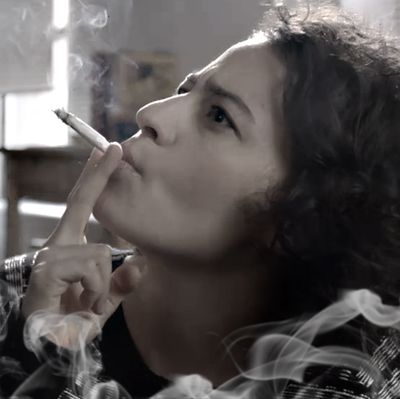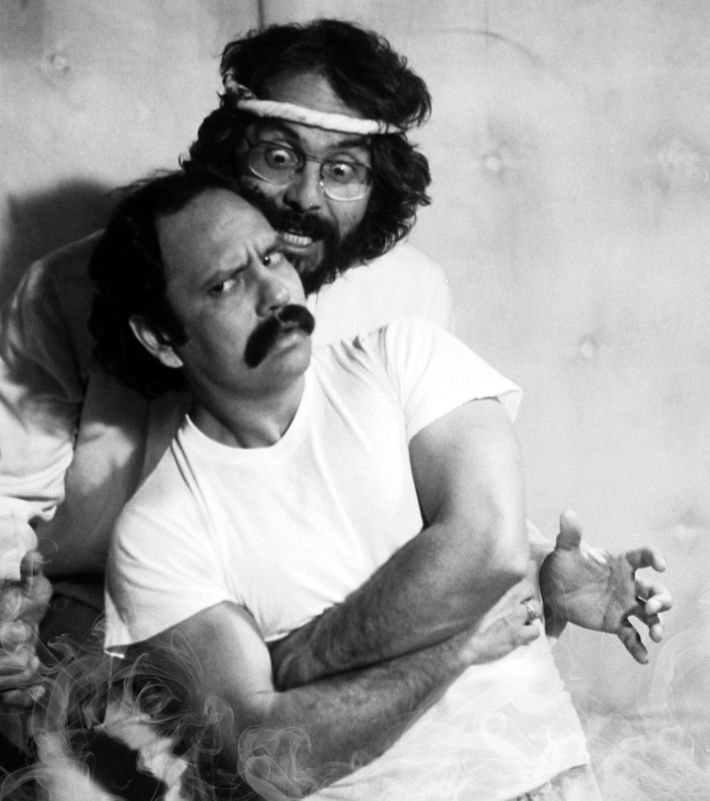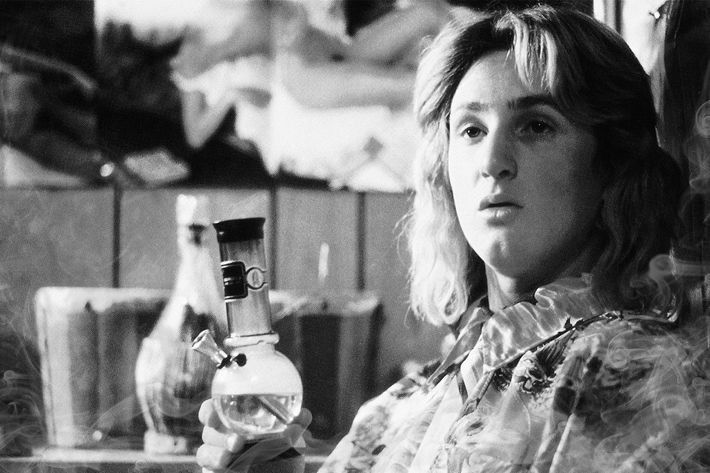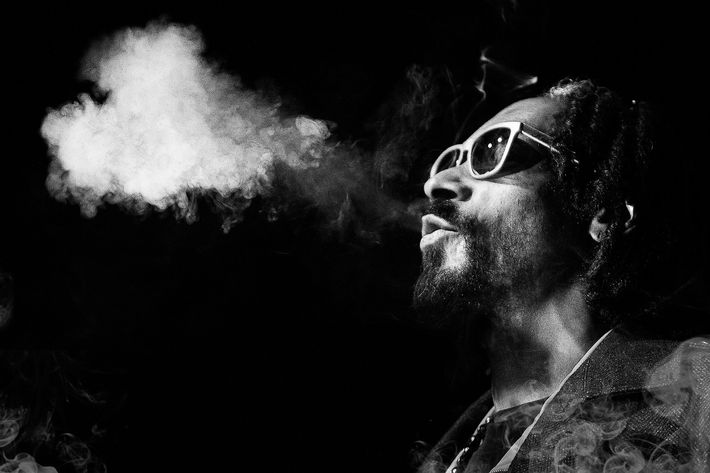
If you want to understand the current state of the stoner in pop culture, it’d be wise to start by watching Broad City’s “P*$$y Weed” episode. While on a desperate odyssey to score, Abbi heads to Washington Square Park, mumbling drug pickup lines to anyone within earshot. Skaters and yuppies stroll past her — equally oblivious to her entreaties. Eventually, a dreadlocked black man in cargo pants sidles next to her on a bench. He mistakenly thinks she’s trying to sell, not buy. Abbi, in turn, confuses him for a dealer. Both walk away dissatisfied — at least until she cops from a squeaky-clean teen wearing a coat and tie.
It’s a classic mistaken-identity comic bit, but it’s also representative: In an America where weed might be less valuable than water, the perception of the stoner has changed. Dealers and smokers are more likely to be embodied by Abbi’s upper-middle-class Jewish girl from Main Line Philly or the hipster courier of High Maintenance than some shambling counterculture type.
Weed and pop culture have been intimately intertwined going back to at least the ‘60s, but as the drug’s standing has changed, becoming widely decriminalized and legalized, it’s depiction — what it stands for — has changed, too. The perceived negative stigma — stoners as protesting dropouts — has gone up in smoke. (After all, nothing countercultural can be sold over the counter.) What was once an act of rebellion, however mild, has become a leisure activity, the best way to make boredom less boring. But rather than resort to Cheech and Chong–derived clichés about shiftless burnouts, Broad City and High Maintenance make us laugh because we relate, not because we’re watching the bleary-eyed antics of some strange “others.” And while, to quote Bill and Ted’s Excellent Adventure, “things are different but the same” — we’re still talking about hedonistic pairs of bleary-eyed comedians. So what, exactly, is our new strain of stoner?
To really understand the evolution of the pop-culture stoner paradigm — and if you’ll forgive a little meandering — you probably have to travel back in time. Maybe the first so-absurd-you-had-to-be-high story comes from the Vedas, the sacred text of Hinduism. According to myth, the goddess Shiva trucked Cannabis down from the Himalayas for “the pleasure of mankind.” A drop of celestial nectar fell to Earth, hemp sprouted on the spot, and, it is believed, a sitar jam-band started playing “Dark Star.”
The American stoner story, though, starts in the middle of the 19th century. A 20-year-old New York writer named Fitz Hugh Ludlow became the Hunter Thompson of his age — an iconoclastic tour-guide of the demimonde — shortly after stumbling upon the latest craze in street narcotics. Immediately intrigued, this sorcerer-bearded son of a prominent abolitionist acquired a ten-grain pill of cannabis extract at his local apothecary, imbibed, and promptly hallucinated like a freshman hitting his first gravity bong. Ludlow then wrote about his fabulous bug-outs in a widely read 1856 article in Putnam’s Monthly magazine, and later compiled is recollections in his blockbuster of the following year, The Hasheesh Eater.
Busy dealing with Civil War and cholera, American bureaucrats somehow neglected to ban the drug. So throughout the latter half of the 1800s, marijuana was legally available, mostly in tincture form manufactured as a panacea by pharmaceutical companies like Lilly and Squibb. This wonder substance was said to cure the aforementioned cholera as well as neuralgia, gout, rheumatism, tetanus, convulsions, depression, delirium tremens, insanity, and uterine hemorrhage, among other ailments.
Pot doesn’t really being to seep into mass culture, though, until the Jazz Age. With customers and cornet players puffing Mexican strains imported through New Orleans and El Paso, weed and music make their first modern connection in the scene centered on Harlem’s Savoy Ballroom. “One reason why we appreciated pot … was the warmth it always brought forth from the other person — especially the ones that lit up a good stick of that shuzzit or gage,” Louis Armstrong told his biographers.
The earliest stoner songs — usually coded messages signaling that the performers were hip hedonists — fittingly emerge from the late 1920s and early ‘30s. Cab Calloway scats on “The Reefer Man.” A young Ella Fitzgerald belted on “When I Get Low, I Get High.” Satchmo contributed “Muggles,” the title a nod to weed’s most common alias at the time. In 1938, Stuff Smith and his Onyx Club Boys cut 1938’s “You’se a Viper” — being a viper enshrined you as a true weed connoisseur. Vipers listened to jazz, dressed and spoke slickly, and had the motto: “Light up and be somebody.”
As the Great Depression lingered and the liquor prohibition was repealed, the Narcotics Bureau shifted gears and began demonizing marijuana. This is where movies like 1936’s Reefer Madness enter the picture and change the perception of a pot-smoker from that of a basically harmless hepcat to a societal threat. Suddenly, headlines started popping up in the syndicates and Hearst press like, “Murders Due to ‘Killer Drug’ Marihuana Sweeping the States.”
In addition to Reefer Madness, other propaganda films like Assassin of Youth and the clunkily titled Marihuana — Weed With Roots in Hell emerged to terrify taxpayers. Branding smokers as sociopaths, the films led into the 1937 Marihuana Tax Act, which outlawed weed, shoving it underground and turning smokers into true outlaws.
We’ve lived through several decades parodying stoners for their false profundities and [Keanu voice] “whoa” moments. It’s most succinctly captured in National Lampoon’s Animal House, when Donald Sutherland’s scorched English professor reveals that one atom in our fingernail could be an entire universe. But no matter how much we satirize stoned thinking, another crop of teenagers will always be staring into the mirror and realizing how weird it is that that we all have eyelashes. In modern American pop-culture, this tradition begins with the Beat generation, a cohort eager to demonstrate their anti-Establishment bona fides. Most notably, we’re talking about Jack Kerouac, Allen Ginsberg, and William Burroughs.
It’s bizarre to think of a poet as a pop-culture celebrity in 2015, but Ginsberg played the role of poet-as-shaman with a self-promotional savvy. “Howl” shattered myths of ‘50s consensus and influenced Bob Dylan’s writing. Rather than expand on existing American drug tradition, the Beats built on the spiritually inclined indulgences of the French visionary hashish eaters: Baudelaire, Rimbaud, Verlaine.
Time and Life magazine made the Beats infamous. Or, more precisely, they drew attention to the cliché of the beatniks, the bongo-slapping, beret-rocking ancestors of hippies and hipsters. Until then, “marihuana smoking” made you akin to a murderer in the conventional middle-American imagination. But as Reefer Madness hysteria started fading, the stoner menace was downgraded to something like “lazy degenerate.”
You can see this embodied by Maynard G. Krebs (Bob Denver) on the CBS sitcom The Many Loves of Dobie Gillis (1959–63). Though unable to light up onscreen, Krebs’s love of jazz and loathing of work and authority confirmed a new stereotype: the stoner as shiftless burnout, wearer of bad facial hair, spiritual godfather of the title character in The Big Lebowski.
The ‘60s are a Kodachrome reel of cliché. Flat-ironed hair and placid nudity, Day-Glo Volkswagens and people dressed exactly like the last two seasons of Mad Men. And the rear view of history distorts everything to cheap dualities between liberation and Manson, Vietnam and Hendrix, Eden or Nixon, smoking weed or being a square.
This decade, though, is when the notion of a stoner band takes flight. The Beatles, the aforementioned Jimi, the Doors, Dylan, Cream, the Dead. Psychedelic light shows, copious drug use, and love beads. The crucial stoner archetype is, of course, the hippie. Instead of inhaling in dingy subterranean jazz clubs like their Keroucian forefathers, stoners now inhaled at open-air rock festivals, signifying an overall attitude of political and social transgression, the altered reality of the drug’s effects a perfect metaphor for the alternate reality that the counterculture hoped to effect.
As the ‘70s unfolded, the baby-boomers shuffled into full-fledged adulthood, and the counter-culture seeped into the mainstream. A 1973 Gallup poll revealed that 12 percent of respondents had tried weed. By 1977, the number had doubled. Comedy received weed-head heroes in George Carlin and Cheech and Chong. The former was cerebral and surly, carrying on Lenny Bruce’s mission to eviscerate conventional mores and orthodoxy. (Carlin’s closest analogue now is longtime marijuana abolitionist Bill Maher, who’d be the first to tell you he’s no George Carlin). Cheech and Chong, for their part, birthed an enduring form of stoner minstrelsy: jobless, careless, and with only enough ambition to roll Sequioa-size spliffs.
You can see that last twosome’s DNA in almost any subsequent stoner-duo comedy (Friday, Harold & Kumar Go to White Castle, and Pineapple Express). These movies vary in quality, but all hammer home the same idea: If you smoke weed, you will crave fast food and be forced to overcome a hilarious series of obstacles that are even harder to do than normal because you’re high.

Other genres had their own stoner icons. Hunter S. Thompson wrote his brilliant Fear and Loathing chronicles and inspired generations of writers to conflate prodigious drug consumption with deep insight. Willie Nelson began his evolution from Nashville songwriter to braided stoner grandpa. Bob Marley introduced American ears to the weed-centric appeal of reggae. These were rebels still, just not particularly dangerous ones. They had the patina of rebellion but, with the occasional exception of Marley, were not really seen as augurs of actual change. They were too lit to get around to anything as daunting as that.
Just as the nation seemed prepared to accept stoners for all their unwashed charms, the ‘80s’ “Just Say No” propaganda and the War on Drugs destroyed any momentum toward normalization. Reagan’s Morning in America meant treating the ‘60s like a bad dream — D.A.R.E. was mandatory in every elementary and junior-high classroom.
Accordingly, a reactionary and conservative tenor filters through the pop culture of the period. Every sitcom has a “Very Special” episode in which it is carefully explained that drugs are a scourge. The biggest pop stars (Madonna, Michael Jackson, Bruce Springsteen) had sharp, crisp images — a far cry from their shaggier predecessors. Even Prince, who played with psychedelic imagery during the decade, was prone to singing things like, “In September my cousin tried reefer for the very first time / Now he’s doing horse / It’s June.” Not long before, pop-culture icons were presenting weed as a gateway to higher consciousness, not as a mere gateway drug.

In the theaters, stoner comedies were mostly low-budget B-movies. Revenge of the Nerds has a single smoking scene, admittedly a classic. In Fast Times at Ridgemont High, the lone pothead — and maybe the decade’s most recognizable stoner — is Sean Penn’s Jeff Spicoli, an adorable monosyllabic surfer-bro who’s most wave-making act is ordering pizza in a classroom.
Most revealing was 1989’s Bill & Ted’s Excellent Adventure, featuring two San Dimas slackers who look they just stepped out of Heavy Metal Parking Lot. In demeanor and bearing, Ted “Theodore” Logan and Bill S. Preston, Esquire, are potheads. Yet neither so much as takes a toke. (Nor does George Carlin, who shows up to lend some secondhand cred.) Stoners weren’t even stoners anymore.
The backlash to the backlash kicked in shortly after Clinton’s inauguration. Baby-boom fueled nostalgia for the 60s and 70s came quickly into vogue and entertainers publicly campaigned for legalization—the Black Crowes, Melissa Etheridge, and Woody Harrelson loop in an endless flashback of 90s MTV News clips about NORML’s marijuana advocacy efforts, and Lollapalooza reawakened a Bacchanalian spirit that had mostly slumbered since Altamont, but it was mostly left to rap to seize the stoner mantle. (Grunge skewed toward heroin.) Dr. Dre’s The Chronic (1992) did more to make weed cool since 1930s Narcotics Bureau Chief Harry Anslinger got it banned it in the first place. Snoop Dogg, too, arrived, to slip into the throne left vacant by Bob Marley. Snoop seems cuddly now, but after decades of doofuses, he and his gangsta rap colleagues restored some seditious edge to the stoner persona.

As far as harbingers go, it was, oddly enough in the era of The Big Lebowski, 1998’s relatively unheralded Half Baked that most clearly signaled shifting attitudes towards pot. Sure, the protagonists (played by Dave Chappelle and Jim Breuer) were slackers; but there was also the cool old man (Willie Nelson), the enhancement smoker (Jon Stewart), the “I’m Only Creative When I’m High” type (Janeane Garofalo), glaucoma patients, and the scavenger smoker (Snoop Dogg). With affectionate parody, Half Baked achieved what legalization advocates had been struggling to articulate for years: Stoners weren’t shifty criminals but regular citizens whose habits were as anodyne as a glass or three of red wine after work. It reflected a process already in motion with the passage of California’s landmark Proposition 215 in 1996, which legalized medical marijuana.
The Bush II years might’ve been a conservative retrenchment that used federal powers to raid growers and dispensaries but, culturally speaking, its efforts were feeble. Attitudes toward medical and recreational uses of marijuana grew increasingly relaxed, and for every article of pop culture recycling old stoner clichés (“Afroman’s “I Got High,” Grandma’s Boy), something else gently contradicted the narrative. Premiering in 2005, Weeds, for example, centered on an ostensibly normal suburban mom (played by Mary-Louise Parker) forced to grow in an attempt to sustain her upper-middle-class lifestyle. The following year, in his memoir, Dreams From My Father, Barack Obama admitted to smoking (unlike Clinton) and suffered no political fallout for doing so.
So where does that leave the stoner in a world where being stoned is no longer subversive? From Wiz Khalifa and Curren$y to A$AP Rocky and Juicy J, hip-hop still boasts its share of stoner icons, but this feels more to do with branding than rebellion. You can now walk into a dispensary in California and purchase marijuana strains named for Ty Dolla $ign, Wiz Khalifa, Freddie Gibbs, or Riff Raff. And Snoop Dogg, diversified businessman that he is, has invested in a weed-delivery start-up.
Even if total national legalization isn’t imminent, no one is shocked to see photos of celebrities like Jennifer Lawrence or Michael Phelps lighting up. Seth Rogen, who via films like Pineapple Express and This Is the End has inherited the mantle of Public Stoner No. 1, comes off less as a dissenting gadfly than he does a mildly dazed schlub-next-door. On Workaholics, Broad City, and High Maintenance, weed is less of a wholesale marker of cool than an idle inhibition. Even the staid folks at the National Geographic network have a show about the green gold rush in Colorado, and Coachella and Burning Man festivals exist as annual open-air drug bazaars. Cheech and Chong would look around and feel at home. Well, mostly. They might have a bit of a hard time recognizing other stoners, because these days, the other stoner is you.


